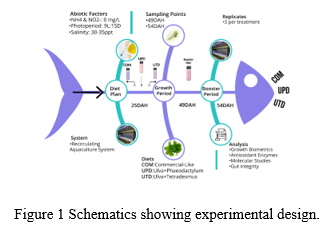ENHANCING SOLE LARVAL ROBUSTNESS WITH ALGAE BASED SOLUTIONS: INSIGHTS INTO GROWTH, REDOX STATUS AND GUT INTEGRITY
Introduction
Marine fish larvae face significant challenges during their early development. During this period, rapid growth, and intense metabolic activity make fish larvae highly vulnerable to oxidative stress; highlighting the critical role of nutrition (Xavier et al., 2021). Algal extracts are rich in bioactive compounds, therefore understanding how these molecules modulate digestive, and redox pathways in postlarval stages of fish is essential (Aragão et al., 2022). This work explores how dietary inclusion of micro- and macroalgae may support larval robustness and resilience through a modulation of growth performance, oxidative stress response, and gut integrity in Solea senegalensis postlarvae.
Materials and methods
In this experiment, sole larvae were fed one of three experimental diets: a commercial-like diet (COM) or two experimental diets supplemented with different combinations of algal products. These combinations used products of the macroalgae Ulva sp. and the microalgae Phaeodactylum (UPD), and Tetradesmus sp (UTD). The experiment lasted 24 days, from 25 days after hatching (DAH) to 49 DAH (Fig.1). After 49 DAH, sole previously fed with the experimental diets (COM, UPD, UTD) were fed with a new diet (Boost) for 5 days, until the end of the experiment (54 DAH).
During the experimental period, postlarvae (initial dry weight 1.24 mg) were reared in triplicate tanks in a recirculating aquaculture system. Throughout the nutritional trial, dissolved oxygen was maintained above 99.5%, temperature at 20.7°C, and pH at 8.1. Growth performance was assessed at 49 DAH. Key oxidative stress markers – superoxide dismutase (SOD), catalase (CAT), and total glutathione (GSH) – along with indicators of macromolecule damage like lipid peroxidation (LPO), as well as the expression of genes related to antioxidant defence (e.g. sod, cat), gut integrity (e.g. cldn15) and immune response (e.g. il-1b), were assessed at 49 and 54 DAH.
Results & Discussion
At 49DAH, the dietary treatments had no significant effects on growth, with larvae presenting a dry weight of 31.18 mg, a total length of 25.89 mm, and a condition factor of 0.89. The relative growth rate was 14.34 % day-1, and the survival rate was 68.41%. After feeding the larvae with the COM and algae-supplemented diets, no clear trend in the antioxidant response was observed. However, after 5 days of feeding the larvae with the boost diet (at 54 DAH), LPO was significantly higher (p < 0.05) in larvae fed the UTD diet compared to those fed the control (COM). A higher LPO is not a positive response. However, as reported by Xavier et al. (2021), sole larvae when fed some doses bioactive compounds can exhibited higher cellular damage, nevertheless after a stressful event may lead to improved resilience. In the present trial, since larvae were not subjected to a challenge, it was not possible to determine whether the boost diet conferred an adaptive advantage. In terms of the molecular markers related to antioxidant defence, gut integrity and immune response, larvae fed the algae-supplemented diets seemed better prepared for a potential challenge, since the expression of genes such as sod, cat, cldn15, and il-1b was upregulated compared to larvae fed the COM diet.
Conclusion
Supplementing microdiets with algae products rich in antioxidants and other bioactive molecules may elicit both beneficial and adverse physiological responses. This dietary fine-tuning underlines the complexity of marine fish larvae nutrition and emphasizes the importance of tailoring diets to enhance larval resilience under hatchery production.
References
Xavier MJ, Conceição LEC, Valente LMP, Colen R, Rodrigues AC, Rocha RJM, Custódio L, Carballo C, Manchado M & Engrola S (2021) Dietary natural plant extracts can promote growth and modulate oxidative status of Senegalese sole postlarvae under standard/challenge conditions. Animals 11, 1398.
Aragão C, Gonçalves AT, Costas B, Azeredo R, Xavier MJ & Engrola S (2022) Alternative proteins for fish diets: implications beyond growth. Animals 12, 1211.
Acknowledgments
This work was financially supported by “Pacto da Bioeconomia Azul” (Project N C644915664-00000026) within the WP5 Algae Vertical, funded by Next Generation EU European Fund and the Portuguese Recovery and Resilience Plan (PRR), under the scope of the incentive line “Agendas for Business and Innovation” through the funding scheme C5–Capitalization and Business Innovation; and by FCT – Foundation for Science and Technology through projects UIDB/04326/2020 (DOI:10.54499/UIDB/04326/2020), UIDP/04326/2020 (DOI:10.54499/UIDP/04326/2020), LA/P/0101/2020 (DOI:10.54499/LA/P/0101/2020) to CCMAR. The authors thank Necton SA for supplying the microalgae.
